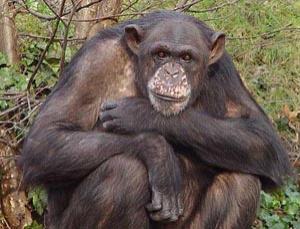An hour at the zoo is enough to convince most people that apes and monkeys are close kin to humankind. Some say that an hour watching proceedings in any parliament is enough to show that humans are close kin to monkeys. Either way, we know that the primate family is an intimate one, with the great apes - gorillas, chimpanzees, bonobos, orang-utans and humans - particularly closely related.

© Wikimedia CommonsChimpanzees (Pan troglodytes) could soon be granted rights.
It did not take genetics to tell us this, however, nor comparative anatomy. We now know that we share many of our genes with insects too, and the anatomies of all mammals are just resized and repositioned versions of one another. The key to understanding the true closeness of apes, ourselves included, is ethology. When Jane Goodall first sat in the Gombe rainforest, giving with fortuitous naivety anthropomorphic interpretations of the chimpanzee behaviour she witnessed, she was initiating a rethink: about apes, about humanity's relationship with them, and ultimately about humanity itself.
A lot has since happened in the almost 50 years since then. Not only has primate ethology flourished, it has influenced sociobiology and evolutionary psychology, and perhaps most importantly for apes themselves it has been a stimulus for the Great Ape Project, which aims to secure a UN declaration granting non-human apes entitlements to life, liberty and freedom from torture and experimentation.
The Great Ape Project was launched in 1993 with the publication of a book edited by philosophers Peter Singer and Paola Cavalieri, and supported by distinguished scientists including Richard Dawkins and Goodall herself. Central to the project's argument is the fact - established by work that Goodall began - that great apes have complex social, emotional and cognitive lives, with self-awareness and capacities for affection and grief. Their genetic proximity to humans is also important: chimps and humans differ in only 1.2 per cent of genes.
The relevance of all this today is that the European Union has just published a much-awaited set of proposals about regulating the use of animals in research, which includes a ban on all medical research on great apes. Studies of great ape behaviour, and research that would protect great ape species from extinction, will still be allowed, and there is an exception for circumstances in which serious epidemic disease might threaten humankind. There has in fact been little experimentation on great apes for some time now, but the ban is nevertheless a remarkable achievement, and a marker on the road to greater controls on all research using animals.
We are already a considerable way down that road. To see how dramatically things have changed, consider this: in one of his letters, the 17th-century philosopher and scientist René Descartes recommends slicing off the apex of a living dog's heart and inserting a finger to feel the strong contractions there. For a long time his approach to the use of animals was the norm.
But no campaigner for animal welfare can be quite satisfied even with today's principle of the "three Rs": reduce the number of animals used in research; refine experimental techniques to minimise animal suffering; replace animals with alternatives whenever possible. For as knowledge increases, so do doubts about the ethics of using any mammal, and even other animals such as crustaceans. There is evidence that lobsters and crabs can experience pain, which makes one shudder at the thought of those lobsters in the restaurant window, claws held with elastic bands, waiting to be thrown into a pot of boiling water.
It makes one think, and once one starts reflecting on ethical boundaries, it's hard not to conclude that they are best drawn as far out as possible.
Reader Comments
to our Newsletter